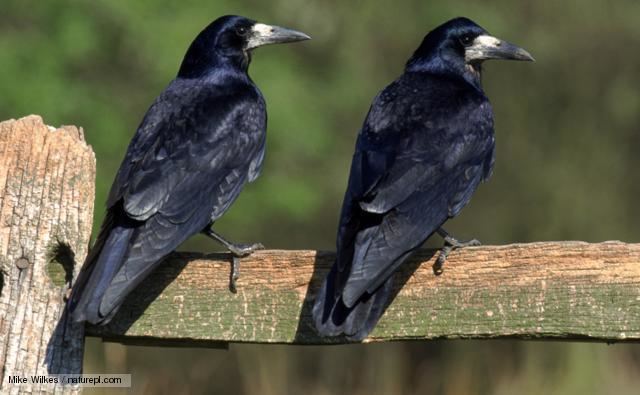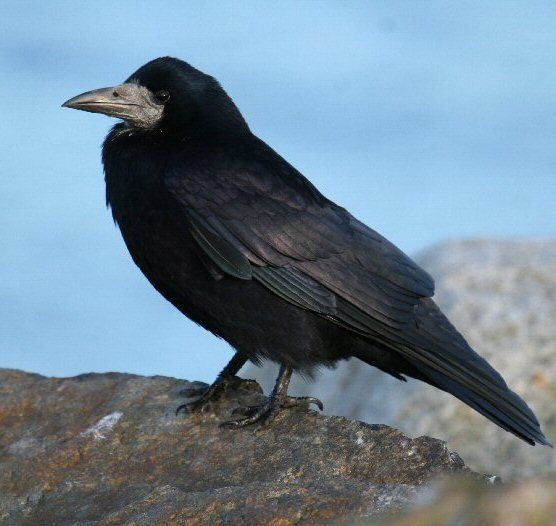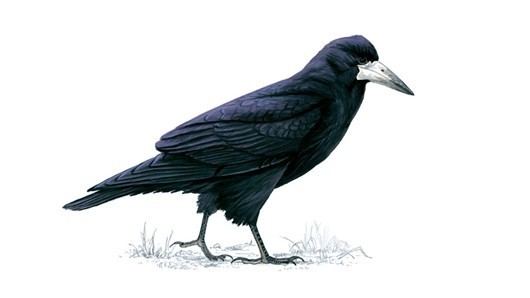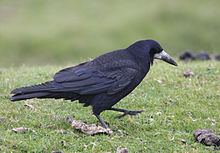Kingdom Animalia Order Passeriformes Species C. frugilegus Mass 340 – 530 g Clutch size 3 – 5 | Phylum Chordata Genus Corvus Scientific name Corvus frugilegus Length 45 – 47 cm (Adult) Higher classification Crow | |
 | ||
Conservation status Least Concern (Population decreasing) Similar Crow, Bird, Western jackdaw, Common raven, Crow family | ||
The rook (Corvus frugilegus) is a member of the family Corvidae in the passerine order of birds. It was given its binomial name by Carl Linnaeus in 1758, The binomial is from Latin; Corvus is for "raven", and frugilegus is Latin for "food-gathering", from frux, frugis, "fruit", and legere, "to pick". The English name is ultimately derived from the bird's harsh call.
Contents

Description

This species is similar in size (45–47 cm in length) to or slightly smaller than the carrion crow with black feathers often showing a blue or bluish-purple sheen in bright sunlight. The feathers on the head, neck and shoulders are particularly dense and silky. The legs and feet are generally black and the bill grey-black.

Rooks are distinguished from similar members of the crow family by the bare grey-white skin around the base of the adult's bill in front of the eyes. The feathering around the legs also looks shaggier and laxer than the congeneric carrion crow. The juvenile is superficially more similar to the crow because it lacks the bare patch at the base of the bill, but it has a thinner bill and loses the facial feathers after about six months. Collective nouns for rooks include building, parliament, clamour and storytelling. Their colonial nesting behaviour gave rise to the term rookery.
Distribution and habitat
Rooks are resident in Great Britain, Ireland and much of north and central Europe but vagrant to Iceland and parts of Scandinavia, where they typically live south of the 60th latitude and in habitats that ravens dislike, such as open agricultural areas. The rook also occurs as an eastern race in Asia where it differs in being slightly smaller on average, and having a somewhat more fully feathered face. In the north of its range the species has a tendency to move south during autumn though more southern populations are apt to range sporadically also. The species has been introduced to New Zealand, with several hundred birds being released there from 1862 to 1874. Although their range is very localised, the species is now regarded as an invasive pest and is the subject of active control. Even so, the ecological and economic impacts of rooks in New Zealand have not been well-studied.
Diet

Food is predominantly earthworms and insect larvae, which the bird finds by probing the ground with its strong bill. It also eats cultivated cereal grain, smaller amounts of fruit, small mammals, acorns, small birds, their eggs and young, and carrion. In urban sites, human food scraps are taken from rubbish dumps and streets, usually in the early hours when it is relatively quiet. It can also be seen along the seashore, feeding on insects, crustaceans and edible flotsam. Like other corvids, rooks in urban or suburban areas will sometimes favour sites with a high level of human interaction, and can often be found scavenging for food in places such as theme parks and piers.
Breeding

Nesting in a rookery is always colonial, usually in the very tops of the trees. Branches and twigs are broken off trees (very rarely picked up off the ground), though as many are likely to be stolen from nearby nests as are collected from trees. Eggs are usually 3–5 in number, can appear by the end of February or early March and are incubated for 16–18 days. Both adults feed the young, which are fledged by the 32nd or 33rd day.
In autumn, the young birds of the summer collect into large flocks together with unpaired birds of previous seasons, often in company with jackdaws. It is during the autumn that spectacular aerial displays can be seen by adult birds that seem to delight in the autumn gales. The species is monogamous, with the adults then forming long-term pair bonds.
Voice
The call is usually described as kaah—it is similar to that of the carrion crow, but usually rather flatter in tone. It is given both in flight and while perched, when the bird fans its tail and bows on each caw. Calls in flight are usually given singly, in contrast to the carrion crow's which are in groups of three or four. Solitary birds often "sing" apparently to themselves, uttering strange clicks, wheezes and human-like notes.
Intelligence
In captivity, when confronted with problems, rooks have been documented as one of several species of birds capable of using tools as well as modifying tools to meet their needs. Rooks learned that if they push a stone off a ledge into a tube, they will get food. The rooks then discovered they could find and bring a stone and carry it to the tube if no stone was there already. They also used sticks and wire, and figured out how to bend a wire into a hook to reach an item. They also seem to have a notion of gravity, comparable to a six-month-old baby and exceeding the abilities of chimpanzees.
In one experiment, a rook was placed near a tube of water, with a worm floating on top of the water, and some rocks next to the tube. The water level was too low for the rook to reach the worm, so it placed rocks into the tube until the level was high enough.
